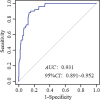Impact of perinatal factors on meconium aspiration syndrome in full-term newborns and the construction of a column chart prediction model: An observational study
- PMID: 38758867
- PMCID: PMC11098210
- DOI: 10.1097/MD.0000000000038279
Impact of perinatal factors on meconium aspiration syndrome in full-term newborns and the construction of a column chart prediction model: An observational study
Abstract
To explore the influence of perinatal-related factors on meconium aspiration syndrome (MAS) in full-term neonates and construct a nomogram prediction model for risk stratification of neonatal MAS and adoption of preventive measures. A total of 424 newborns and their mothers who were regularly examined at our hospital between January 2020 and December 2023 who had meconium-contaminated amniotic fluid during delivery were retrospectively selected as participants. Neonates were divided into MAS and non-MAS groups based on whether MAS occurred within 3 days after birth. Data from the 2 groups were analyzed, and factors influencing MAS were screened using multivariate logistic regression analysis. The R3.4.3 software was used to construct a nomogram prediction model for neonatal MAS risk. Receiver operating characteristic (ROC) curve analysis and the Hosmer-Lemeshow goodness-of-fit test were used to evaluate the performance of the model, and its clinical effectiveness was evaluated using a decision curve. Among the 424 neonates with meconium-stained amniotic fluid, 51 developed MAS within 3 days of birth (12.03%). Multivariate logistic regression analysis showed that a low amniotic fluid index before delivery (OR = 2.862, P = .019), advanced gestational age (OR = 0.526, P = .034), cesarean section (OR = 2.650, P = .013), severe amniotic fluid contamination (OR = 4.199, P = .002), low umbilical cord blood pH (OR = 2.938, P = .011), and low neonatal Apgar 1-min score (OR = 3.133, P = .006) were influencing factors of MAS in full-term neonates. Based on the above indicators, a nomogram prediction model for MAS risk of full-term newborns was constructed. The area under the ROC curve of the model was 0.931. The model was also tested for goodness-of-fit deviation (χ2 = 3.465, P = .903). Decision curve analysis found that the model was clinically effective in predicting the net benefit of MAS risk in neonates with meconium-stained amniotic fluid. The construction of a column chart prediction model for neonatal MAS risk based on prenatal amniotic fluid index, gestational age, delivery method, amniotic fluid contamination level, newborn umbilical blood pH value, and Apgar 1-min score has a certain application value.
Copyright © 2024 the Author(s). Published by Wolters Kluwer Health, Inc.
Conflict of interest statement
The authors have no conflicts of interest to disclose.
Figures




Similar articles
-
[Clinical features of severe meconium aspiration syndrome (MAS) and early predicting factors for severe MAS in neonates with meconium-stained amniotic fluid].Zhongguo Dang Dai Er Ke Za Zhi. 2022 Jun 15;24(6):662-668. doi: 10.7499/j.issn.1008-8830.2202011. Zhongguo Dang Dai Er Ke Za Zhi. 2022. PMID: 35762433 Free PMC article. Chinese.
-
Risk factors for meconium aspiration in meconium stained amniotic fluid.J Obstet Gynaecol. 2007 Aug;27(6):577-9. doi: 10.1080/01443610701469636. J Obstet Gynaecol. 2007. PMID: 17896254
-
Establishment and evaluation of nomogram for predicting acute respiratory distress syndrome in meconium-stained amniotic fluid neonates.Pediatr Pulmonol. 2025 Jan;60(1):e27345. doi: 10.1002/ppul.27345. Epub 2024 Nov 27. Pediatr Pulmonol. 2025. PMID: 39601453
-
Tracheal suction at birth in non-vigorous neonates born through meconium-stained amniotic fluid.Cochrane Database Syst Rev. 2021 Jun 16;6(6):CD012671. doi: 10.1002/14651858.CD012671.pub2. Cochrane Database Syst Rev. 2021. PMID: 34133025 Free PMC article.
-
Effects of induction of labor prior to post-term in low-risk pregnancies: a systematic review.JBI Database System Rev Implement Rep. 2019 Feb;17(2):170-208. doi: 10.11124/JBISRIR-2017-003587. JBI Database System Rev Implement Rep. 2019. PMID: 30299344 Free PMC article.
Cited by
-
Analysis of the current situation and demand for perinatal education in pregnant women in general grade A tertiary hospitals in China: a cross-sectional survey.BMJ Open. 2024 Aug 9;14(8):e079044. doi: 10.1136/bmjopen-2023-079044. BMJ Open. 2024. PMID: 39122391 Free PMC article.
References
-
- Kumar A, Kumar P, Basu S. Endotracheal suctioning for prevention of meconium aspiration syndrome: a randomized controlled trial. Eur J Pediatr. 2019;178:1825–32. - PubMed
-
- Haakonsen Lindenskov PH, Castellheim A, Saugstad OD, et al. . Meconium aspiration syndrome: possible pathophysiological mechanisms and future potential therapies. Neonatology. 2015;107:225–30. - PubMed
-
- Chettri S, Bhat BV, Adhisivam B. Current concepts in the management of meconium aspiration syndrome. Indian J Pediatr. 2016;83:1125–30. - PubMed
-
- Oommen VI, Ramaswamy VV, Szyld E, et al. . Resuscitation of non-vigorous neonates born through meconium-stained amniotic fluid: post policy change impact analysis. Arch Dis Child Fetal Neonatal Ed. 2021;106:324–6. - PubMed
-
- Hiersch L, Krispin E, Aviram A, et al. . Effect of meconium-stained amniotic fluid on perinatal complications in low-risk pregnancies at term. Am J Perinatol. 2016;33:378–84. - PubMed
Publication types
MeSH terms
LinkOut - more resources
Full Text Sources

